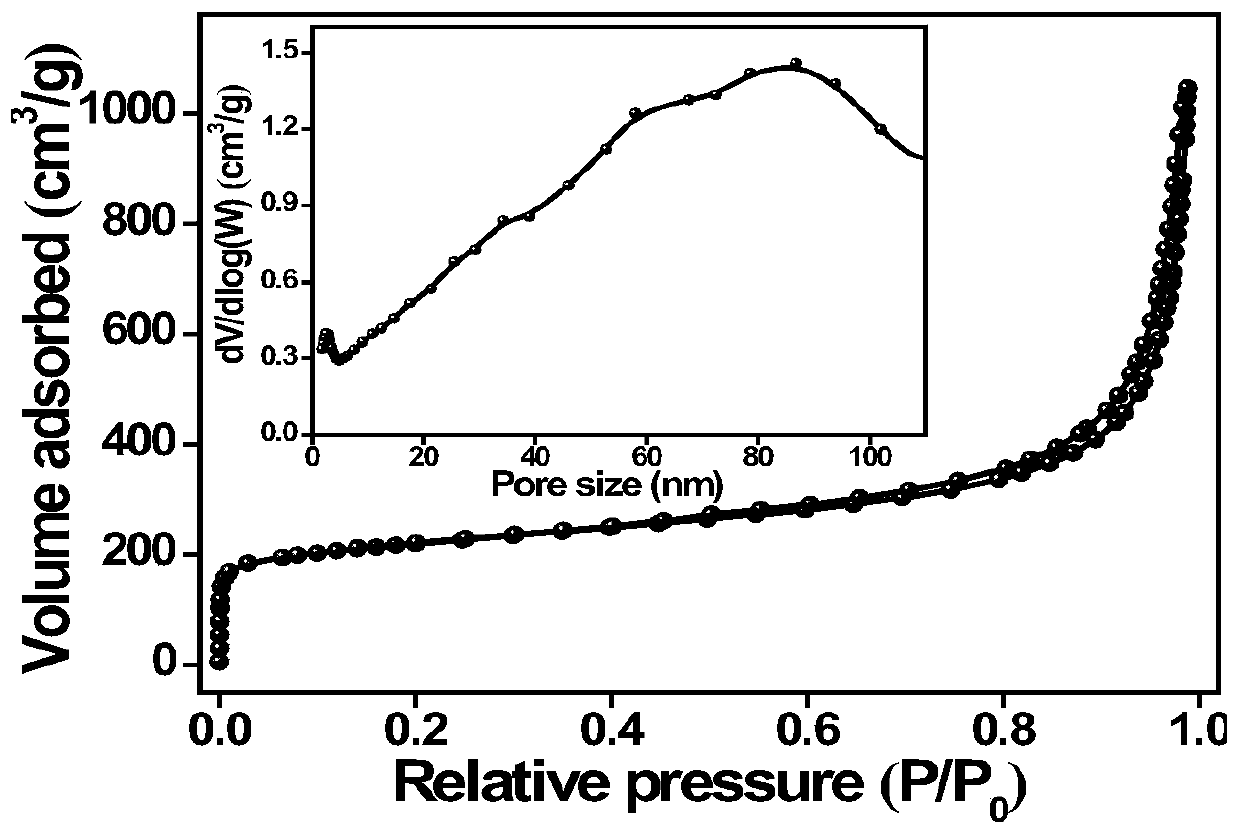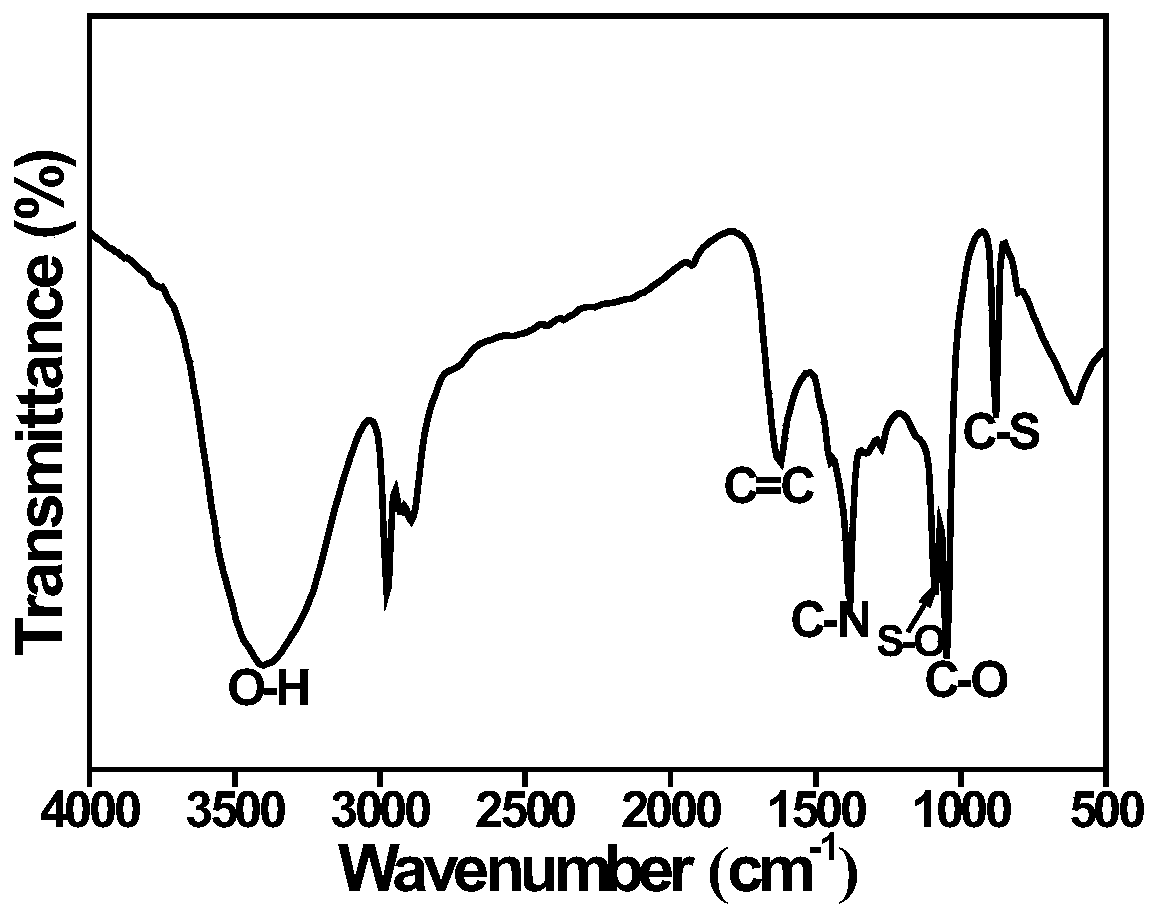Preparation method and application of double-heteroatom doped porous graphene nano carbon sheet
A technology of carbon nanosheets and heteroatoms, which is applied in the interdisciplinary field of materials and analytical chemistry, to achieve good UV absorption performance, good UV absorption capacity, and simple preparation methods
- Summary
- Abstract
- Description
- Claims
- Application Information
AI Technical Summary
Problems solved by technology
Method used
Image
Examples
Embodiment 1
[0050] 1. Under stirring conditions at room temperature, take 0.65g thiourea, 1.401g citric acid and 17.55g sodium chloride and dissolve them in secondary water until completely dissolved, then freeze the mixed solution in liquid nitrogen, and Dried to a powder in a lyophilizer for later use.
[0051] 2. Heat the above sample under an argon atmosphere at a heating rate of 5°C / min to 750°C for 2 hours. After cooling down to room temperature, the obtained product is washed twice with water to remove excess sodium chloride and dried. Afterwards, nitrogen- and sulfur-doped porous graphene-like carbon nanosheets (N,S-C) were obtained. Through analysis and detection, the carbon content is 80.68%, the oxygen content is 6.62%, the nitrogen content is 10.86%, and the sulfur content is 1.84%.
[0052] The SEM and TEM characterizations of the prepared N,S-C nanosheets are shown in figure 1 ,From figure 1 As can be seen in a, the material exhibits interconnected graphene-like nanosheet...
Embodiment 2
[0054] 1. Under stirring conditions at room temperature, take 1.3g thiourea, 1.401g citric acid and 17.55g sodium chloride and dissolve them in secondary water until completely dissolved, then place the mixed solution in liquid nitrogen to freeze, and Dried to a powder in a lyophilizer for later use.
[0055] 2. Heat the above sample under an argon atmosphere at a heating rate of 5°C / min to 750°C for 2 hours. After cooling down to room temperature, the obtained product is washed twice with water to remove excess sodium chloride and dried. Afterwards, nitrogen- and sulfur-doped porous graphene-like carbon nanosheets (N,S-C) were obtained. Through analysis and detection, the carbon content is 77.79%, the oxygen content is 6.62%, the nitrogen content is 12.66%, and the sulfur content is 2.93%.
Embodiment 3
[0057] 1. Under stirring conditions at room temperature, take 0.65g thiourea, 2.802g citric acid and 17.55g sodium chloride and dissolve them in secondary water until completely dissolved, then place the mixed solution in liquid nitrogen to freeze, and Dried to a powder in a lyophilizer for later use.
[0058] 2. Heat the above sample under an argon atmosphere at a heating rate of 5°C / min to 750°C for 2 hours. After cooling down to room temperature, the obtained product is washed twice with water to remove excess sodium chloride and dried. Afterwards, nitrogen- and sulfur-doped porous graphene-like carbon nanosheets (N,S-C) were obtained. Through analysis and detection, the carbon content is 83.49%, the oxygen content is 3.81%, the nitrogen content is 10.86%, and the sulfur content is 1.84%.
PUM
| Property | Measurement | Unit |
|---|---|---|
| thickness | aaaaa | aaaaa |
| specific surface area | aaaaa | aaaaa |
| pore size | aaaaa | aaaaa |
Abstract
Description
Claims
Application Information
 Login to View More
Login to View More - R&D
- Intellectual Property
- Life Sciences
- Materials
- Tech Scout
- Unparalleled Data Quality
- Higher Quality Content
- 60% Fewer Hallucinations
Browse by: Latest US Patents, China's latest patents, Technical Efficacy Thesaurus, Application Domain, Technology Topic, Popular Technical Reports.
© 2025 PatSnap. All rights reserved.Legal|Privacy policy|Modern Slavery Act Transparency Statement|Sitemap|About US| Contact US: help@patsnap.com



